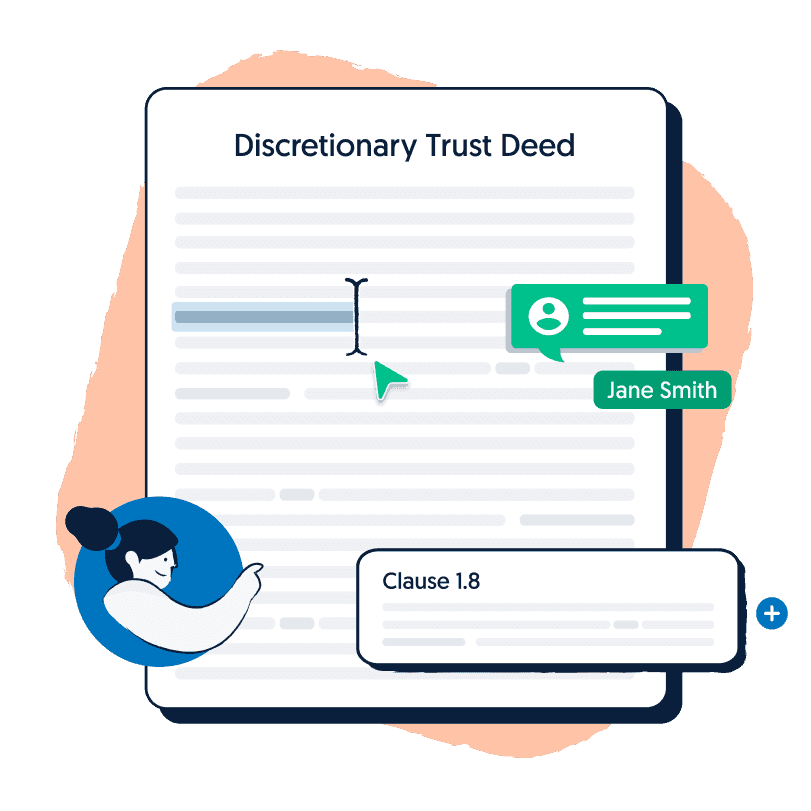Based in Sydney, Raja is a law student enrolled in a Bachelor of Laws and Bachelor of Communications (Writing and Publishing) at the University of Technology Sydney. He is passionate about transferring knowledge in relation to businesses, legal advice and marketing direction. Raja has experience working in immigration law and is driven by the writing, editing and publishing process of content.
💡 Key insights
1. A family trust (discretionary trust) separates legal ownership (held by a trustee) from beneficial ownership (held by beneficiaries), giving trustees flexibility to decide how much and to whom trust income is distributed.
2. Choosing the right appointor, trustee, settlor, and beneficiaries is critical: the appointor controls who can remove or replace trustees, and the trust deed defines who gets distributions and under what rules.
3. Setting up a family trust involves: drafting a custom trust deed, having the settlor settle a small amount, executing the deed, paying any required stamp duty, applying for a TFN (and ABN if needed), then opening a dedicated bank account.
4. A family trust offers both asset protection (by legally separating family assets from personal ownership) and tax planning benefits, such as income splitting to beneficiaries in lower tax brackets.
Are you thinking about setting up a family trust (or a discretionary trust) in Australia but don’t know how to do it then you have come to the right place!
Setting up a family trust doesn’t need to be a complicated process if you follow the proper steps, and we’re here to help you navigate the process of a family trust setup in no time.
Table of Contents
What Is A Trust?
A trust is a legal relationship where only one party holds and manages assets for the benefit of another. The person or entity responsible for managing the assets is called the trustee, while those who benefit from the trust are called the beneficiaries.
Trusts are commonly used to manage and protect assets, support family members, or structure the finances of a business in a tax-effective and flexible way.
Note: A trust itself doesn’t own any property, it’s not a separate legal entity. The trustee holds legal ownership of the assets on behalf of the beneficiaries. This distinction is often misunderstood, as people may refer to the “trust owning” an asset. It is the trustee who owns and controls the asset legally, but only in their capacity as trustee, not in their personal capacity. trustee can also be a beneficiary of a trust but cannot be the only beneficiary.
A trustee can also be a beneficiary of a trust but cannot be the only beneficiary
What Is A Family Trust
A family trust is a type of discretionary trust set up to hold and manage assets for the benefit of family members.
In a family trust, a person or company (called the trustee) is legally responsible for holding and managing the trust property for the benefit of one or more beneficiaries.
It’s called a discretionary trust because the trustee has the discretion to decide how the trust’s income and capital are distributed. This means the trustee:
- Can choose which beneficiaries receive income or assets from the trust
- Can decide how much each beneficiary receives
- Has flexibility to adjust distributions from year to year depending on circumstances
Note: To access certain tax concessions and franking credit benefits, the trustee may choose to make a Family Trust Election (FTE) with the Australian Taxation Office (ATO). This formally nominates a test individual and their family group as the trust’s beneficiaries for tax purposes, ensuring compliance and preventing unintended distributions outside the family group.
Protecting your Assets
A trust can protect the ownership of your assets while you are alive. You can transfer the legal ownership of the assets to the trust while continuing to use and enjoy them as long as you’re listed as a beneficiary.
For example, if the family home is in a trust, you no longer personally own the house – but you could still live in it if that’s what the trust deed states.
Family trusts can also be used to protect selected assets against claims and creditors. For example, to protect your family home from the potential failure of a business venture.
Tax Planning and Tax Benefits
Choosing a family trust entity can allow a trustee and its beneficiaries to arrange their tax affairs to minimise their tax liability through the ATO.
The trustee decides who gets the income and capital the trust owns.
This could suit someone in the highest tax bracket with family members listed as beneficiaries at lower rates.
For example, rental income from an investment property owned by the trustee could go to members of the trust on lower incomes. The same principle also applies to the taxing of dividend payments from shares owned by the trustee.
Other Purposes
Family trusts are also made for the following purposes:
- Managing and protecting family assets, such as property or investments.
- Running a family business while allowing family members to benefit without being directly involved in management.
- Distributing wealth flexibly, for example, to support children or dependants.
- Passing assets between generations in a controlled and tax-effective way.
- Minimising tax by distributing income to beneficiaries on lower tax rates.
Now that you have a good understanding of what family trusts are let’s get into the steps required to create the trust.
A trust deed can also include rules about who qualifies as a beneficiary. For example, it may limit distributions to lineal descendants (such as children and grandchildren) or exclude certain individuals or entities. This flexibility allows families to tailor the trust to their specific needs and values.
How To Set Up A Family Trust
Step 1: Choose the Key Players
Before you can establish a family trust, you’ll need to carefully select the key parties involved. Each role has distinct legal responsibilities and plays an important part in how the trust operates and is controlled. Making the right choices here will influence how the trust functions, how it’s managed over time, and how smoothly it transitions between generations.
Appointor
The appointor (sometimes called the principal or guardian) is arguably the most important person in the trust structure. The appointor has the power to remove and replace the trustee, effectively maintaining ultimate control over who manages the trust.
Because of this power, it’s critical to think about succession planning. You should decide what happens if the appointor passes away, loses capacity, or no longer wishes to act. Many families choose to name successor appointors (for example, a spouse or adult child) in the trust deed to ensure continuity and avoid disputes later.
In some cases, co-appointors are used (such as both parents acting together), but it’s important to define how decisions will be made if they disagree. The appointor should always be someone who understands the family’s goals and can be trusted to act impartially and responsibly.
Trustee
The trustee is the person or company that legally owns and controls the trust assets. While the trustee’s name appears on titles and bank accounts, they do not personally own those assets—they hold them on trust for the beneficiaries.
The trustee is responsible for managing the trust’s assets, keeping financial records, and making distribution decisions in line with the trust deed and relevant laws. They also owe fiduciary duties to the beneficiaries, meaning they must always act in good faith and in the beneficiaries’ best interests.
You can appoint either:
- An individual trustee (e.g. a parent or trusted family member), or
- A corporate trustee (a company set up to act as trustee).
A corporate trustee is often preferred for asset protection and administrative ease. It separates personal and trust assets, reduces personal liability, and ensures continuity if individuals involved change or pass away.
Settlor
The settlor is the person who formally creates the trust by signing the trust deed and contributing a small amount of money (known as the settlement sum, usually $10). The settlor’s role is purely procedural — they bring the trust into existence but then step away.
Importantly, the settlor must not be a beneficiary of the trust and should ideally be someone unrelated to the family (such as an accountant or lawyer). This ensures there are no tax or legal conflicts of interest. Once the deed is executed and the settlement sum handed over to the trustee, the settlor has no further rights or responsibilities.
Beneficiaries
The beneficiaries are the people or entities who benefit from the trust — they are the ultimate recipients of income, capital, or property distributed by the trustee.
Beneficiaries are usually defined in two ways:
- Named beneficiaries: Individuals or entities specifically listed in the trust deed (e.g. “John and Mary Smith”).
- Classes of beneficiaries: Broader categories such as spouses, children, lineal descendants, grandchildren, and family companies or trusts. This approach provides flexibility for future generations, allowing the trustee to include family members who may not yet exist when the trust is created.
The trust deed can also include restrictions — for example, limiting distributions to lineal descendants (bloodline family only) or excluding certain individuals. This allows families to protect assets from external claims, relationship breakdowns, or future disputes.
Beneficiaries do not own the assets directly but have a beneficial interest in them. They have the right to be considered when distributions are made and may have enforceable rights if the trustee breaches their duties.
Step 2: Draft the Discretionary Trust Deed
The trust deed is the legal foundation of the family trust. It sets out the rules for how the trust operates and how income and capital can be distributed.
A well-drafted deed should cover:
- The appointment, powers, and removal of trustees
- The identity and powers of the appointor (and succession on death or incapacity)
- How income and capital can be distributed
- Whether lineal descendants are preferred or restricted as beneficiaries
- What happens if a trustee or appointor dies
- Indemnities and record-keeping requirements
This is also where you can customise your trust — for example, limiting beneficiaries to family members, adding clauses about asset protection, or defining how future generations benefit.
Step 3: Settle and Sign the Deed
Once the deed is drafted:
- The settlor signs and provides the settlement sum to the trustee.
- The trustee accepts their appointment and signs the deed.
- The parties date and witness the document.
This can be done in person or electronically under current legislation. Once signed, your family trust legally exists and can proceed to stamping (if required) and registration steps.
Step 4: Pay The Stamp Duty
Once the trust is established and signed, you may need to formally stamp the family trust deed.
Stamp duty differs state by state, so applications differ within states and territories. The rates below apply for trusts over non-land assets.
Pay The Stamp Duty
Once the trust is established and signed, you may need to formally stamp the family trust deed.
Stamp duty differs state by state, so applications differ within states and territories. The rates below apply for trusts over non-land assets.
The costs of stamping your discretionary trust are as follows:
| New South Wales | $750 with $10 per additional stamped copy. Mailing address must be stamped by a registered OSR lodger. This stamp must also be within 3 months from the date of execution |
| Victoria | $200 with no charge for additional copies. Mailing address must be stamped by a registered Duties Online Agent. This stamp must also be within 3 months from the date of execution. |
| Australian Capital Territory | Stamp duty is not payable or required. No time limit is imposed for stamping. |
| Queensland | Stamp duty is not payable or required. No time limit is imposed for stamping. |
| South Australia | Stamp duty is not payable or required – deeds may still be stamped “exempt” No time limit is imposed for stamping. Mailing address: Revenue SA. |
| Western Australia | Stamp duty is not payable or required. No time limit is imposed for stamping. |
| Northern Territory | $20 with $5 per additional copy. Mailing address: Commission of Taxes |
Step 5: Apply for an ABN and TFN
Once your family trust has been established and executed, you’ll need to apply for a Tax File Number (TFN) with the Australian Taxation Office (ATO).
A TFN is mandatory — every trust must have one so that it can lodge annual tax returns and meet its tax obligations.
An Australian Business Number (ABN), on the other hand, is only required if the trust is carrying on a business or registering for GST. Not all family trusts need an ABN — for example, if the trust simply holds investments or property, a TFN is usually sufficient.
Your lawyer or accountant can advise whether your trust needs an ABN based on its activities and structure.
Step 6: Open a Separate Family Trust Bank Account
We have reached the final step. Congratulations.
The final step is to open a bank account for the trust. It should be opened in the trustee’s name ‘as a trustee for the trust.’
The first deposit into the account should be the settlement sum. This sum should be there before any other deposits or transactions are made.
Frequently Asked Questions – F.A.Qs
Can a trust be a form of a business structure?
A trust can be a business structure. However, running a business through a trust is generally only recommended in specific circumstances. Trusts can become complex to manage when it comes to raising capital, bringing in new investors, or selling the business, as ownership and control sit with the trustee rather than the beneficiaries. If you’re considering operating a business through a trust, please reach out to us to discuss whether this structure suits your long-term goals and business plans.
Is it worth setting up a family trust?
Setting up a family trust is a great way to hold a family’s assets, use them for estate planning, or conduct a family business.
Why would you set up a family trust?
A family trust provides asset protection by separating legal ownership (held by the trustee) from beneficial ownership (held by the beneficiaries), safeguarding assets from personal liabilities. It also offers tax benefits, allowing income to be split among beneficiaries in lower tax brackets, reducing overall tax liability by distributing income or assets to family members at advantageous tax rates, making it an effective tool for wealth management.
How much does it cost to set up a trust account?
The cost of setting up a trust account will depend on where you choose to set it up and what type of trust you choose. Use our calculator above to determine prices for you.
Can a single person set up a family trust?
Yes, a single person can set up a family trust during their lifetime to manage assets, investments, and support beneficiaries, such as family members.
However, the trustee and the beneficiary cannot be the only individuals involved. The trust can still be set up with a sole appointor, one company trustee, and the same named beneficiary. The key is ensuring there is a clear separation of roles and interests within the trust structure.
Who is a beneficiary in a trust account?
Beneficiaries are the people or objects that will benefit from the trust, money or property.
What other types of trust structures can I choose?
There are several types of trust structures, each designed for specific purposes. Some common types include:
- Fixed Unit Trust: In this structure, beneficiaries hold units in the trust, similar to shares in a company. Their entitlement to income or capital is fixed and based on the number of units they hold.
- Unit Trust Deed: A unit trust is governed by a unit trust deed that outlines how the units are distributed among beneficiaries and how the trust is managed.
- Bare Trust Deed: A bare trust involves a trustee holding assets on behalf of a beneficiary, with no active management or discretion over distributions. The beneficiary is the sole person entitled to the trust’s income and assets.
Superannuation Trusts: These trusts hold assets for the benefit of members and are used in the context of retirement savings, governed by specific superannuation rules.
Note: This article specifically focuses on discretionary family trusts. Other types of trusts have special rules and tax implications, which can vary depending on their purpose and structure. If you are considering any of these other trust structures, please reach out to us for professional advice tailored to your needs.
Is it worth setting up a family trust in Australia?
Yes, a family trust can help protect assets, minimise tax, and manage wealth for future generations. It is particularly useful for families with investments, business interests, or multiple beneficiaries.
How much does it cost to set up a family trust in Australia?
A: Setting up a family trust in Australia typically costs A$1,500–A$2,500, plus potential stamp duty depending on your state. Legal and accounting advice may add to the cost.
How much does it cost to set up a family trust in Australia?
Setting up a family trust usually costs A$1,500–A$2,500, with extra fees possible for professional advice or state-based stamp duties.
Key Takeaways
Setting up a family trust offers numerous benefits, including asset protection and tax advantages. By separating legal ownership (held by the trustee) and beneficial ownership (held by the beneficiaries), a family trust can protect assets from personal liabilities. It also allows for tax-efficient income distribution, helping to reduce overall tax liability by distributing income to family members in lower tax brackets.
When setting up a family trust, key decisions include selecting the appointor, trustee, settlor, and beneficiaries. The trust deed outlines how the trust operates and can be tailored to suit your needs, such as including lineal descendants or specific beneficiary classes.
The process involves drafting and executing the trust deed, settling the trust with a small sum, paying stamp duty (if required), and applying for an ABN and TFN. Finally, a trust bank account should be opened.
While family trusts are ideal for managing family assets and wealth, other types of trusts, such as unit trusts or superannuation trusts, have specific rules and tax implications. Always consult with a professional to ensure the structure meets your long-term goals.








